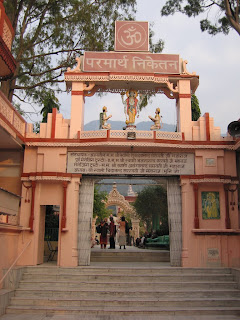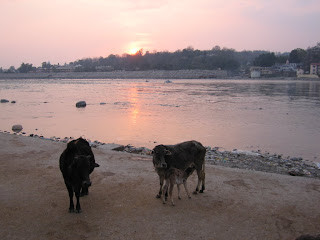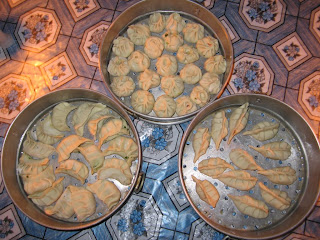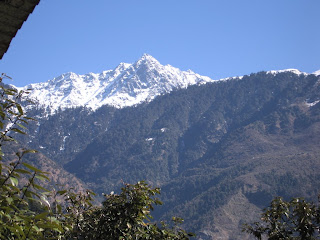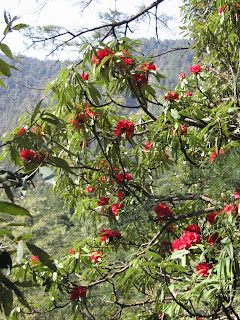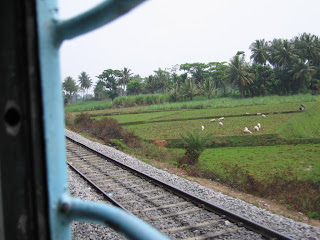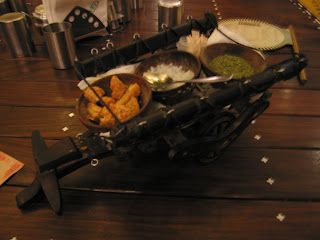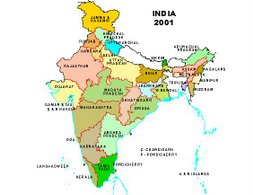This is my final post to this blog and in it I aim to present a small summary of the concept of yoga as I understand it after my experience in India, because I believe a lot of people are confused by all the different styles of yoga and do not clearly understand that yoga is not just a form of exercise. This little summary might not be completely correct and it might give rise to some discussion or constructive criticism, which I appreciate. This summary can be used as an introduction into my blog and after you have read it, I suggest you read the posts from oldest to latest, unless you are looking for something specific, in which case you can use the specific labels, which you will find on the right hand side.
What is yoga?
Literally yoga means "union" or "to yoke". Yoga is the union of breath with the body, of the mind with the muscles, and the self (or soul) with the divine. Yoga is not a religion and does not require you to believe in a certain God or chant certain mantras. It is an ancient Indian discipline which leads to health in the body, peace in the mind, joy in the heart and liberation of the soul. Liberation of the soul? In this context, I believe liberation of the soul does not mean union with the divine after death, but liberation from anger, greed, worry, desires, despair and depression.
Often the reason for our unhappiness on a personal level is the fact that we are constantly at odds between our mind and our heart, our desires and our fears. We feel alone, anxious and scared.
In our families and communities we criticize each other and compete with each other, "My style of yoga is better than yours." And we devide ourselves by nations, religions and colour. Yoga in its most complete meaning is the panacea for all that which ails us and devides us.
Here's a dictionary definition of yoga:
Yoga: n 1: Hindu discipline aimed at training the consciousness for a state of perfect spiritual insight and tranquility that is achieved through the three paths of actions and knowledge and devotion
2: a system of exercises practiced as part of the Hindu discipline to promote control of the body and mind [Hindi, from Sanskrit yoga, union, joining.
Note the paths of action, knowledge and devotion. There are many types of yoga that don't even include doing poses like down dog or tree. This is because yoga is not just physical exercise. There is yoga that only focus on obtaining knowledge of sacred texts. There is yoga that is all about devotion and service.
Types of Yoga
- Hatha Yoga
Hatha literally means "sun meets moon" and this type of yoga emphasizes specific physical postures or asanas. The ultimate goal of practicing difficult postures, however, is not a toned bum or flexible hamstrings, though these are sometimes the by-product of a yoga practice. The ultimate goal, if we are to really do yoga, is to force the mind to withdraw from the outside world to create perfect spiritual insight and tranquility. Hatha yoga provides us with a healthy body, which is a stepping stone towards achieving a still mind.
There are many different styles of yoga:
Anusara, Ashtanga, Bikram, ISHTA, Iyengar, Jivamukti, Kripalu (derived from Kundalini), Kriya, Power, Restorative, Shinto, Sivananda, Vinyasa (Flow).
These are all forms of Hatha yoga and I suggest people try out different styles to find one that suits them. There is a good comparison of the most popular styles / kinds of yoga in the February edition of the Yoga Journal.
Ashtanga yoga was and is taught by Pattabhi Jois in Mysore, India. A few decades ago westerners started going to Mysore to practice with Jois, or Guruji, as he is called. They brought the practice to the U.S., Europe, well now pretty much all developed countries have ashtanga yoga. Guruji, now at 91 years of age, is not the only ashtanga teacher in India, but he is by far the most popular.
Iyengar yoga is called Iyengar after the instructor who popularized this type of yoga. BKS Iyengar, who is also in his 90's, teaches in Pune, India.
BKS Iyengar and BNS Iyengar, along with Pattabhi Jois, learnt yoga from their guru Sri T. Krishnamacharya. While Jois and BNS today teach the vinyasa based form of yoga known as ashtanga, BKS focused on breaking down postures and working on the alignment. Iyengar yoga is sometimes referred to as "prop yoga", because of the use of props such as blocks, straps and blankets. If you are a detail oriented person, who doesn't mind a lot of verbal instruction by the teacher, Iyengar yoga may be the thing for you and it is a great base for understanding alignment. It can also be a good choice if you are practicing with injuries.
- Japa / Mantra Yoga
- Karma Yoga
- Jnana Yoga
- Bhakti Yoga
- Raja Yoga
The yoga sutras explain yoga as an eight-limbed tree. Ashtanga means "eight limbs", but when we refer to Ashtanga Yoga, we all mean the practice of the asanas, which is only one limb. When Pattabhi Jois named the style of yoga he developed, from what he learned from his guru, he meant it as a reminder to practice all eight limbs and not just the asanas. Yoga is a way of life and its teachings should penetrate every aspect of our being from your actions to your speech to your thoughts.
There is a style of Yoga called Integral yoga, which integrates the various branches / forms / types of yoga mentioned above.
The eight limbs of Raja Yoga
There are many many translations of the yoga sutras and I have tried to identify, through discussion with people who have read some of them and by reading reviews on them, the most easily readable translations. I have put links to two of the ones I have identified as easily readable on the blog on the right hand side.
As mentioned earlier, yoga is not a religion and none of the eight limbs depends on one's spiritual belief system and it does not matter what name or form of the divine you worship.
The first four limbs are considered the external limbs, and the last four limbs the internal limbs.???? The order of the limbs is important and the first two limbs are the foundation of the "tree", the moral and ethical code of conduct.
1. Yamas (actions)
a) Ahimsa: non-violence
b) Satyam: truthfulness
c) Asteya: not stealing
d) Brahmacharya: restraint and moderation
This is frequently translated as celibacy or abstinance, but after more research, I found the following description: one whose actions are pure and holy, to create loyal, honest and loving relationships bringing us closer and closer to God.
e) Aparigraha: non-accumulation/non-hoarding
"There is more than enough for everyone's need, but not enough for any man's greed." Mahatma Ghandi. We need to realise that nothing belongs to us, we are merely lending it for certain period of time, and the more we try to accumulate, the more we acquire, the more we are bogged down and the more difficulties we face.
2. Niyamas (observances)
a) Suacha: refraining from putting anything impure into our being (drugs, cigarettes, negative gossip, pornography etc)
b) Santosha: contentment
We should strive for an attitude of gratitude instead of hungering for more (possessions and achievements).
c) Tapas: practice of tolerance
taking control over our volatile mind, emotions and insatiable senses
d) Swadhaya: study of the scriptures
We should read something spiritual and inspiring every day, but we should also use introspection as a tool to examine our lives, just like a businessman examines his balance sheet.
e) Ishwra pranidhana: devotion to God
3. Asana (Seat on which to sit to practice yoga - control of the body)
Asana (or the physical posture) is not the yoga, it is the preparation for the practice of yoga. We must not stop with asana, the asana readies us for the higher limbs of yoga.
4. Pranayama (prolonging our life force and energy - control of the breath)
As the breath becomes still, slow, deep and steady we find that our lives also become calm, collected and centred.
5. Pratyahara (withdrawal of the senses - control of the senses)
Turning the object of our senses from the external to the internal.
6. Dharana (singleminded concentration - control of the mind)
To channel all thought-power in one direction and stop the incessant wanderings of the mind.
7. Dhyana (meditation)
Not to be confused with concentration, where there is a subject (you) and an object (what you are concentrating on). In meditation all borders, boundaries and seperation between the universe and us begin to disappear and we begin to realise the inherent oneness of all beings and all creation. At first we will need a technique to get us there, but once we are in a meditative state, we do not need a technique any more.
8. Samadhi (to merge)
This is the ultimate goal of enlightenment.
